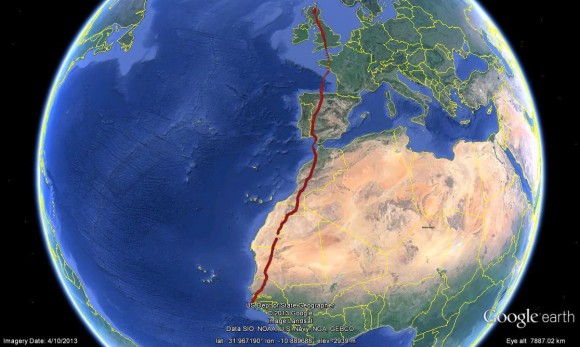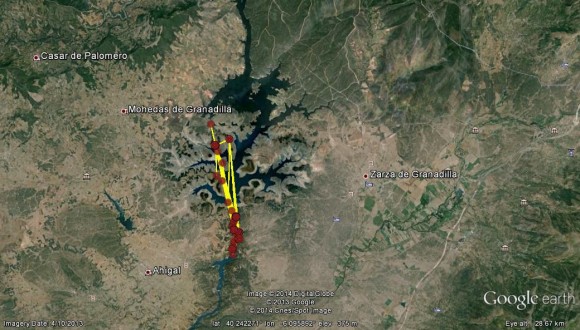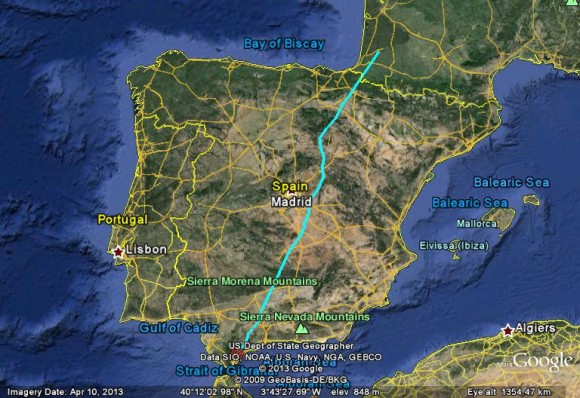Blue XD crossed The Gambia yesterday and finally roosted SE of Dafar after another 82 km. He started his migration today at 048GMT and by 1837GMT was roosting south of Louga in northen Senegal after a day’s migration of 213 km. Tomorrow he should cross the River Senegal and once he is heading towards the Sahara desert he will be out of range of mobile phone masts and we may not hear anything until he reaches Morocco.
Blue XD sets off north
Blue XD set off on migration at 1038GMT this morning, after an early fishing session, and by the time of the last transmission of the day had flown 109 km NE and had reached the Lower River in The Gambia. At that time he was flying E at 10knots at an altitude of 922metres. It’s going to be exciting following his jouney especially as today GPS data was being gathered at 1 or 2 minute intervals uisng the GSM system.
Yellow HA
Yellow HA was ringed as a male chick at nest B15 near Glenferness in Nairn on 8th July 2003. His mother had come from Norway while his brother was satellite tagged and made a successful migration to West Africa and wintered at the mouth of the Senegal River, before the battery went flat. Yellow HA was first identified at FindhornBay in 2007, and was seen again in 2009 and 2010 in the bay and visiting nests trying to find a mate and a nest. In fact it was looking good for him in 2010 at next B10 but he was kicked out by the later returning male. In 2011, he took over that nest and paired up with Morven and bred there successfully for last three years. He regularly fishes in FindhornBay. His transmitter, fitted in July, was one of the new GSM/GPS transmitters which communicate data through the mobile phone system.
He left FindhornBay on 26th September, a late migratory, and reached his winter quarters in the Sine Saloum National Park in Senegal on 14th October. He made frequent trips from his night-time roost in the mangrove swamps to fish around and roost on Ile d’Oiseaux. This is a favourite place for ospreys and where we filmed ospreys for the BBC Autumnwatch programme in 2012. May be I saw him that winter flying to and from the island.
Blue XD
Blue XD was ringed as a two-year old male at Rothiemurchus Fishery on 12th August 2000 and I refound him as the breeding male at a nest near Carrbridge in 2002. He bred there each year until 2009; then his mate failed to return from Africa in 2010 and he moved to nest A11 to pair up with Green J. He has bred there each year since and is regulalrly seen fishing at Rothiemurchus Fishery as well as on the River Findhorn near Tomation and at Lochindorb. His transmitter in 2013 is one of the new GSM/GPS Microwave Telemetry models which send data to the mobile phone system, and in sunny conditions can collect GPS at one minute intervals. This photo was taken on 31st July 2013 by Neil Macgregor.
Last autumn he left his eyrie at 0730GMT on 10th September and migrated to the outer marshes of the River Casamanche in southern Senegal. He arrived there at 1530GMT on 22nd September after flying 5455 km in 13 days. This is a very fast accurate migration considering that the direct distance is 5060 km.
Green J
Green J was ringed as a single chick in nest G07 in Easter Ross on 10th July 1991. I identified her as the breeding female at nest A11, near Carrbridge, in 1997, and she was probably there from 1994 or 1995. She has bred every year since then and has had a total of at least 23 chicks. One of her chicks was the very first chick translocated to Rutland Water and her young have contributed to the Rutland project as well as to the Andalucian and Basque osprey recovery projects. In 1999, she was the first osprey to be satellite tagged and we proved over the next three winters that she lived on the Gabriel y Galan Reservoir in Extremadura, and did not travel to Africa. An old osprey, like Green J at 23 years of age, is particularly interesting for understanding the behaviour of ospreys at the end of their breeding life. Last summer, the new GPS satellite tag showed that Beatrice returned to exactly the same location in Spain and we could see how she had settled at Gabriel y Galan reservoir.
Still waiting
Rothiemurchus is still at his wintering site to 14th March but should start migrating soon.
Stopping-over in souhern France
Beatrice is still at her favourite stop-over site on the River Adour but is ranging more widely this spring.




























